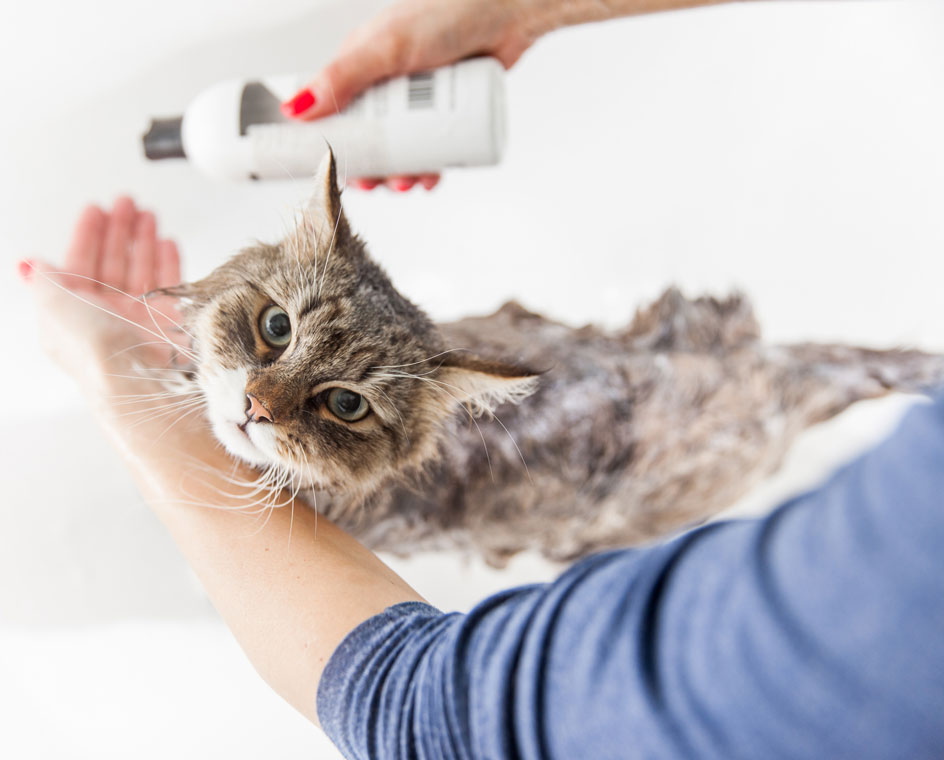- Home
- Tips for Giving a Cat a Bath

Tips for Giving a Cat a Bath

When your cat needs a bath, it can be a daunting thought. Most cats dislike being bathed, and you might have visions of being clawed or bitten while trying to get Fluffy squeaky clean.
The good thing is that most cats don't need routine bathing. They only need it in certain extenuating circumstances.
When Do Cats Need Baths?
Your cat might need a bath in the following circumstances:
- He's gotten a chemical or foul substance on his fur or skin that you don't want him to lick off.
- He has a skin condition for which your vet has prescribed bathing with medicated shampoo.
 He's otherwise gotten dirty or stinky.
He's otherwise gotten dirty or stinky.
In fact, if you bathe your kitty too often, he may develop dry skin or other skin problems.
If you do need to give your cat a bath, use a mild, medication-free cat shampoo or one that your vet has prescribed.
Tips for Bathing a Cat
Here are some general tips to keep in mind when you need to give your cat a bath:
- If you know your cat will need periodic baths and doesn't like them, consider outfitting him with Soft Paws. That will help keep you from getting scratched.
- If the bath is not an emergency (i.e., you don't need to remove a toxic substance from the cat's body), wear him out with a vigorous play session first.
- Use a non-slip mat or towel on the bottom of the sink or tub. Cats get upset when they slide around and feel unstable.
- Put two inches of warm water in a sink or tub. Test it with the inside of your wrist to ensure it isn't too hot.
If you know your kitty is too much for you to handle giving a bath too, make an appointment with a professional groomer instead. If the case is that there is a toxic substance on the kitty, go to the vet's office for help.
- Fill some large cups with water too and have them on hand to use for rinsing. Turning on running water and using it to rinse the kitty will probably scare and upset him.
- Close the door of the room you're bathing the kitty in so if he escapes, he won't be able to get out into another room and hide.
- Stay calm yourself. Never yell at or punish your cat for being scared or not cooperating with a bath. That will only make it worse next time.
 Wear a long-sleeved shirt to protect your arms.
Wear a long-sleeved shirt to protect your arms.- Recruit someone to help you. One of you can gently keep the kitty in one spot while the other gives the bath.
- Avoid getting the ears and face wet if possible. Pour water on the kitty gently with cupped hands or your filled cups. If necessary, use a washcloth to clean the face and head.
- When you're done, use a towel to dry your cat well. After you've blotted the kitty dry as much as possible, brush her to help dry her more and get any tangles out of her fur.
- Keep the kitty in a warm, draft-free area until fully dry.
- Use treats and praise for positive reinforcement. Remember to stay calm and positive throughout the procedure.
It's best if you can slowly get your cat used to bathing over time rather than getting into a situation where you must do it and the kitty has never experienced it before. That way, you can take it in steps and use more time to get the cat used to the bathtub and the water.
One way to do that is to play with your kitty in the dry tub or sink with a toy. Then put a tiny bit of water in the tub with the toy. Over time, your cat might get used to the idea of being in the tub and getting wet.
Sometimes, it's not safe for you to give a bath at home because your cat might bite or scratch. If that's the case, you might need a groomer.
For more at-home grooming tips for cats, check here: "Cat Home Grooming Tips."

 Loading... Please wait...
Loading... Please wait...




